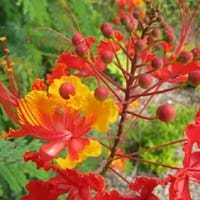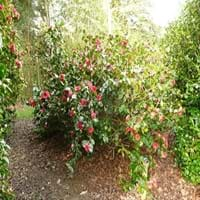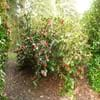Life Span
Annual
Perennial
Type
Shrub
Broadleaf Evergreen
Origin
Latin America and the Caribbean
China, Japan, Korea
Types
Not Available
Not Available
Number of Varieties
Not Available
Habitat
Warmer regions
Dappled Shade, Shady Edge, Woodland Garden
USDA Hardiness Zone
9-12
7-9
Sunset Zone
H1, H2, 12, 13, 14, 15, 16, 18, 19, 20, 21, 22, 23
4, 5, 6, 7, 8, 9, 12, 14, 15, 16, 17, 18, 19, 20, 21, 22, 23, 24
Habit
Upright/Erect
Oval/Rounded
Flower Color
Yellow, Red, Orange
Light Pink
Flower Color Modifier
Multi-Color
Not Available
Leaf Color in Spring
Green
Dark Green
Leaf Color in Summer
Green
Dark Green
Leaf Color in Fall
Green
Dark Green
Leaf Color in Winter
Green
Dark Green
Leaf Shape
bipinnate
Ovate
Plant Season
Spring, Summer, Fall, Winter
Spring, Summer, Fall, Winter
Sunlight
Full Sun, Partial Sun
Partial Sun, Partial shade
Growth Rate
Very Fast
Medium
Type of Soil
Loam, Sand
Loam
The pH of Soil
Acidic, Neutral, Alkaline
Acidic, Neutral
Soil Drainage
Well drained
Average
Bloom Time
Indeterminate
Early Spring, Late Winter
Tolerances
Drought, Salt
Not Available
Where to Plant?
Ground, Pot
Ground, Pot
How to Plant?
Seedlings
Cuttings, Seedlings
Plant Maintenance
Medium
Medium
Watering Requirements
Never Over-water, Requires regular watering
Average Water Needs, Do Not over Water
In Summer
Lots of watering
Drought Tolerant, Average Water
In Spring
Moderate
Moderate
In Winter
Average Water
Average Water
Soil pH
Acidic, Neutral, Alkaline
Acidic, Neutral
Soil Type
Loam, Sand
Loam
Soil Drainage Capacity
Well drained
Average
Sun Exposure
Full Sun, Partial Sun
Partial Sun, Partial shade
Pruning
Remove damaged leaves, Remove dead branches, Remove dead leaves
Remove damaged leaves, Remove dead branches, Remove dead leaves
Fertilizers
All-Purpose Liquid Fertilizer
10-10-10, 8-8-8
Pests and Diseases
Red blotch
Black Mold, Flower Blight, Free of serious pests and diseases, Leaf Gall, Leaf spot
Plant Tolerance
Drought
Not Available
Flower Petal Number
Single
Double
Foliage Texture
Fine
Medium
Foliage Sheen
Matte
Glossy
Attracts
Hummingbirds, Butterflies
Butterflies
Allergy
Not Available
no allergic reactions
Aesthetic Uses
Showy Purposes
Bonsai
Beauty Benefits
Not Available
Not Available
Edible Uses
Sometimes
Yes
Environmental Uses
Air purification
Air purification
Medicinal Uses
anti-inflammatory, antimicrobial, Bronchitis, Chest pain, Cough, Fever, Kidney Stones, Malaria, Purgative, Sore Eyes, Sore throat
Astringent, Cancer, Haemostatic, Salve, Tonic
Part of Plant Used
Flowers, Leaves, Root
Flowers, Leaves, Seeds
Other Uses
Medicinal oil, Used As Food, Used as Ornamental plant
As a tea substitute, Used as a hair-dressing oil, Used for making green dye
Used As Indoor Plant
Sometimes
Yes
Used As Outdoor Plant
Yes
Yes
Garden Design
Feature Plant, Mixed Border, Screening, Wind Break, Tropical
Feature Plant, Foundation, Mixed Border, Topiary, Bonsai, Espalier
Botanical Name
CAESALPINIA pulcherrima
CAMELLIA japonica 'Debutante'
Common Name
Pride of Barbados
Camellia, Debutante Camellia, Japanese Camellia
In Hindi
Pride of Barbados
Japanese Camellia
In German
Stolz von Barbados
Japanische Kamelie
In French
Fierté de la Barbade
Camellia japonais
In Spanish
Orgullo de Barbados
Camelia japonesa
In Greek
Υπερηφάνεια των Μπαρμπάντος
Ιαπωνικά Camellia
In Portuguese
Offs Pridi Varvias
Camellia japonês
In Polish
Pridi offs Varvias
Japoński Camellia
In Latin
Pridi offs Varvias
Camellia Italica
Phylum
Angiosperms
Magnoliophyta
Class
Magnoliopsida
Magnoliopsida
Genus
Caesalpinia
Camellia
Clade
Angiosperms, Eudicots, Rosids
Angiosperms, Asterids, Eudicots
Tribe
Not Available
Theaeae
Subfamily
Not Available
Theoideae
Number of Species
Not Available
Not Available
Season and Care of Pride of Barbados and Japanese Camellia
Season and care of Pride of Barbados and Japanese Camellia is important to know. While considering everything about Pride of Barbados and Japanese Camellia Care, growing season is an essential factor. Pride of Barbados season is Spring, Summer, Fall and Winter and Japanese Camellia season is Spring, Summer, Fall and Winter. The type of soil for Pride of Barbados is Loam, Sand and for Japanese Camellia is Loam while the PH of soil for Pride of Barbados is Acidic, Neutral, Alkaline and for Japanese Camellia is Acidic, Neutral.
Pride of Barbados and Japanese Camellia Physical Information
Pride of Barbados and Japanese Camellia physical information is very important for comparison. Pride of Barbados height is 240.00 cm and width 240.00 cm whereas Japanese Camellia height is 210.00 cm and width 165.00 cm. The color specification of Pride of Barbados and Japanese Camellia are as follows:
Pride of Barbados flower color: Yellow, Red and Orange
Pride of Barbados leaf color: Green
Japanese Camellia flower color: Light Pink
- Japanese Camellia leaf color: Dark Green
Care of Pride of Barbados and Japanese Camellia
Care of Pride of Barbados and Japanese Camellia include pruning, fertilizers, watering etc. Pride of Barbados pruning is done Remove damaged leaves, Remove dead branches and Remove dead leaves and Japanese Camellia pruning is done Remove damaged leaves, Remove dead branches and Remove dead leaves. In summer Pride of Barbados needs Lots of watering and in winter, it needs Average Water. Whereas, in summer Japanese Camellia needs Drought Tolerant, Average Water and in winter, it needs Average Water.





